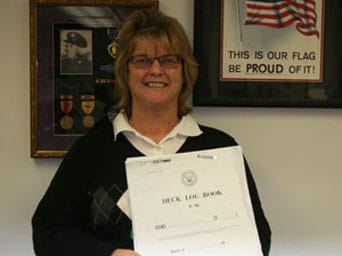

Documents indicate jungle use in 1962
By JON MITCHELL
Special to The Japan Times
Recently uncovered documents show that the United States conducted top-secret tests of Agent Orange in Okinawa in 1962, according to a veterans services employee.
The experiments, believed to have taken place under the auspices of Project AGILE — a classified program to research unconventional warfare techniques — have also been confirmed by a former high-ranking American official.
The documents, which include a ship’s logbook, army deployment orders and declassified government records, were tracked down by Michelle Gatz, a veterans service officer in Yellow Medicine County, Minnesota.
While assisting a former soldier who claims he was poisoned by these defoliants at military ports in Okinawa in the early 1960s, Gatz pieced together the paper trail of how the chemicals were transported from the U.S. to the island aboard the merchant marine ship SS Schuyler Otis Bland.
“The ship’s logbook shows it was carrying classified cargo that was offloaded under armed guard at White Beach (a U.S. Navy port on Okinawa’s east coast) on 25 April, 1962,” Gatz told The Japan Times.
The Bland was a civilian-owned ship regularly employed by the U.S. Navy to transport defoliants incognito and that was able to bypass customs inspections of military vessels entering foreign ports.
Three months prior to its arrival at Okinawa, the Bland had traveled to South Vietnam to deliver one of the Pentagon’s first shipments of defoliants. After departing Okinawa in spring 1962, the Bland sailed to the Panama Canal Zone where, the Panamanian government asserts, the U.S. tested Agent Orange in the early 1960s.
Recently, more than 30 U.S. veterans — all of them suffering from diseases consistent with dioxin-exposure — have spoken to The Japan Times about the presence of Agent Orange at 15 military installations in Okinawa, causing widespread alarm that the prefecture remains polluted by notoriously persistent dioxins.
The U.S. government has repeatedly denied assistance for these ailing veterans, claiming Agent Orange and similar herbicides were never present in Okinawa. However, the U.S. government still refuses to release large sections of its records related to the defoliant tests it conducted in the 1960s.
Gatz believes the Bland’s cargo was used in some of these tests — namely Project AGILE, which was tasked with finding how chemicals could deprive enemy soldiers of jungle cover and crops.
The publicly accessible pages of the project show that in 1962, the military was growing impatient with the inconclusive results of early defoliation experiments in South Vietnam, so it ordered an unspecified group in Army Chemical Biological Research “to develop advanced dissemination systems for defoliating vegetation.”
After filing a request with the Army College in Pennsylvania under the Freedom of Information Act, Gatz was able to pinpoint what she believes to be the precise unit — the U.S. Army’s 267th Chemical Service Platoon.
“The 267th was formerly stationed in Alaska, but the records show that in 1962, it was inexplicably reactivated, then transferred to Okinawa. It was brought there to conduct defoliant tests on the island’s tropical vegetation,” says Gatz.
The 267th Chemical Service Platoon was also involved in “Operation Red Hat,” the military project that shipped 12,000 tons of U.S. biological and chemical weapons out of Okinawa before its reversion to Japan, according to veterans’ testimonies and a 2009 ruling on defoliants by the Department of Veterans Affairs.
A retired American high official made headlines in The Okinawa Times last September when his account broke the military’s wall of silence by claiming that the Pentagon had tested defoliants in the island’s northern jungles near Kunigami and Higashi villages.
In an interview with the newspaper, the official, who declined to be named, stated that Okinawa was selected for such experiments due to its vegetation’s similarities to that of Vietnam and the lack of strict safety regulations that curtailed potentially dangerous tests elsewhere.
After reading the chain of events pieced together by Gatz, the retired official, who asked to remain anonymous, confirmed that her assertions were correct. However, he added that he was concerned for Gatz’s job security now that she was going public with her findings.
Gatz says she is determined to pursue the truth no matter what the consequences.
“These documents are the smoking gun. Now there is no way that the Department of Defense can continue to deny defoliants were ever on Okinawa. It’s time they owned up and started giving these sick veterans the justice they deserve.”
Source: www.japantimes.co
ATTENTION READERS
We See The World From All Sides and Want YOU To Be Fully InformedIn fact, intentional disinformation is a disgraceful scourge in media today. So to assuage any possible errant incorrect information posted herein, we strongly encourage you to seek corroboration from other non-VT sources before forming an educated opinion.
About VT - Policies & Disclosures - Comment Policy



